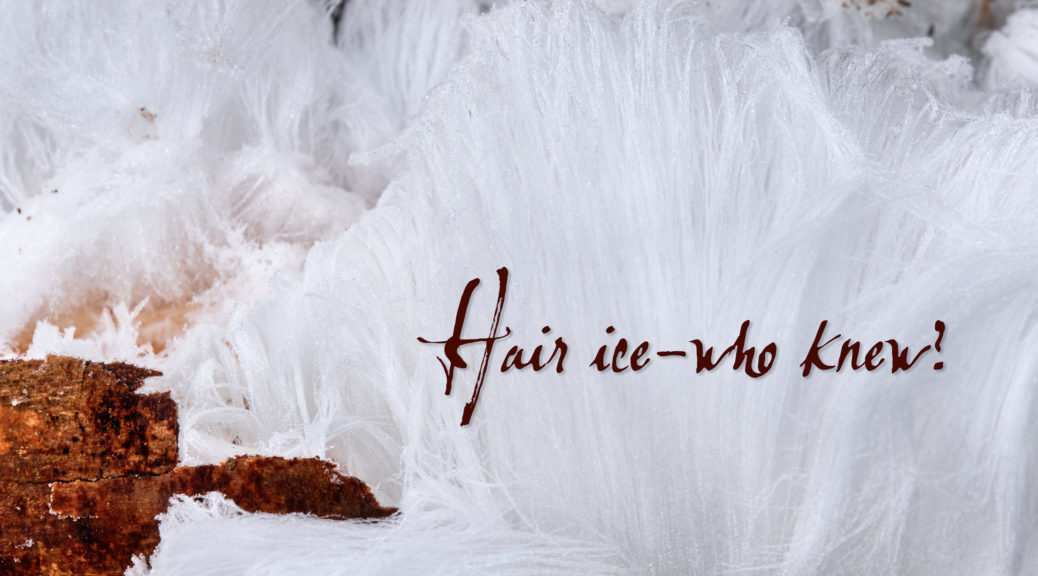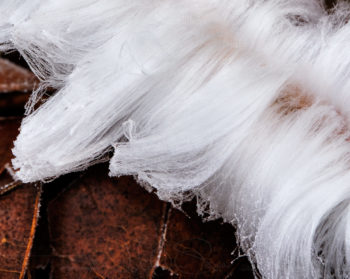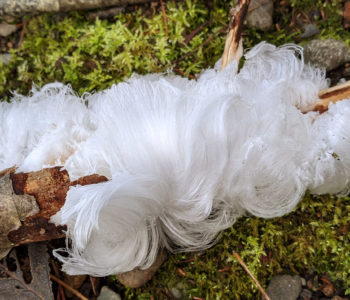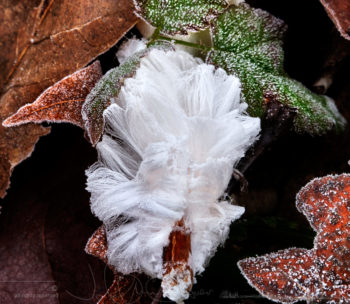Most mornings, and Boxing Day was no exception, I enjoy a mug of tea in the kitchen window seat where the woods behind our house provide a simple and soothing view. This time of year there’s little color, but the backdrop is varied browns of fallen leaves, and branches coated with moss and lichens. Against those muted Winter tones, the bright white object on the ground at the edge of the woods stood out – not a pale stone or mushroom cap, but something aggressively and purely white. I worried it was a small animal – an owl or coyote’s prey – and thought I should take a look.
It was a cold and slightly foggy early morning – frost on the grass and the previous week’s record rainfall still hadn’t completely drained away. Looking at the white “thing” up close, I realized I hadn’t seen anything like this in the woods in the nearly 20 years we’ve lived here and presumed it was a fungus of some kind. With so much moisture in the ground around us, which sits on top of glacial clay, many types of wild mushrooms grow in the woods and in our garden. I am largely clueless about what’s safe to eat and what will kill me, so I stay away from anything I didn’t buy at the local market. I looked around and saw various other small fungal growths, including the pretty one above, which I believe is a shelf fungus.
The fine white strands and the fullness and curl of many strands was really lovely so I took a couple of pictures with my phone. Walking back to the house, I noticed many more of these white “eruptions” in a corner of the yard and began to worry this might be something problematic – meaning something I had to find a contractor to deal with before it got out of hand. It sounds paranoid, but we have three pumps keeping our home dry, a system of drainage pipes that tree roots would like to call home and “the unexpected” makes my brain visualize dollar signs!
I washed my hands carefully (still thinking it was a fungus), even though I hadn’t picked it up, and asked Google to tell me about white fungus strands. The first set of images showed a picture of what I’d found in the woods (along with many others of soil problems and bean molds). It wasn’t a fungus at all but ice, known as hair ice, ice wool or frost beard – all lovely names that sound like they belong in a story about magical locations in the far north.
Time was of the essence if I wanted more pictures – once it warmed up these amazing formations would be gone. I grabbed camera, macro lens, kneeling gardening stool, and tripod. After clambering about to get pictures, I got the kids out of bed (adult kids who don’t much like early mornings, let alone frosty ones!) as it seemed worth a field trip to see with their own eyes versus just through photographs. After we came in to warm up, I tweeted and posted one of my smart phone pictures and then did some searching online to learn more about this amazing ice. Partly just because I was curious, but also because I need to keyword stock images accurately.
One of the many delightful things about this experience is that it was only four years ago that scientists finally confirmed how this ice formed. A team of researchers set out to see if an idea from 1918 (Alfred Wegener had first observed hair ice) was correct, that a fungus was an essential part of the formation of hair ice. The team published their findings in an open-access journal Biogeosciences so you can read the details of how they went about the work and what they found.
Summarizing their findings, it’s a very specific set of conditions that lead to hair ice formation. The reservoir of water – below freezing but still liquid – is inside the dead wood. Last week’s record rains soaked everything and the woods became wetlands temporarily. A specific fungus, Exidiopsis effusa (typically found from 45 to 55 degrees north) is growing in the wood. The temperatures are below freezing and the air is still. The research team knows something – possibly from the fungus – is preventing the large crystals typically found when ice slightly melts on the surface and then re-freezes. The process of freezing on the surface of the wood draws more liquid water from inside the porous wood lengthening the fine “hair” strands of ice.
So many things about this discovery made my day.
-I’m 65 and encountered something I’d never seen before.
-We have soaking rains every winter; the woods are always littered with fallen branches and dead leaves; but in almost 20 years I have never spotted this phenomenon.
-Some smart and capable scientists have only just figured this mystery out – in 2015. I don’t know who was paying their salaries to do this work, but I’m heartened that someone was so we (humans) can continue to figure things out even if we don’t have a blockbuster drug or a trip to Mars as the goal.
-Visually, this ice was stunning – and my daughter noted how soft the ice was to the touch. You don’t get to feel it for long though as the tiny strands melt almost instantly when touched.
-The ephemeral nature of this beautiful structure was a delight too – you must take it in now as it’s gone by lunchtime and no guarantee when you’ll see it again.
-I love the fact that I can feed Google a good guess for a search term and find out so much about what I’d seen. Arguably the old fashioned way – having to get on my bike and cycle down to the local library – had the added benefit of exercise, but it’s a delight to be able to answer so many questions as they come up.
-And the fungus won’t require any fixing!
All in all, a delightful day.






